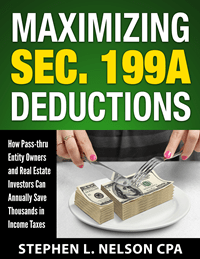The new Section 199A deduction requires taxpayers to identify the individual trades or businesses they receive income from.
The reason for this identification? The 20% deduction you calculate looks at trades or businesses individually.
Example: You own two businesses: a pet food factory and a consulting firm. Probably in this case, you make two separate Section 199A calculations for the two separate businesses.
Why the Internal Revenue Service Even Cares
The IRS makes business owners “break down” operations into individual trades or businesses for two reasons.
First, specified service trades or businesses (hereafter SSTBs) lose part or all of the Section 199A deduction if the owner’s taxable income gets high enough.
Note: SSTBs include doctors, lawyers, accountants, consultants, investment bankers, financial planners and a handful of other potentially high income high “personal service” businesses like performers and athletes.
Second, all businesses potentially see their Section 199A deduction limited based on the business’s wages and depreciable property if the business owner’s taxable income rises high enough.
Note: For more information about how the SSTB or wages or depreciable property phase-out rules work, click here.
In any case, as a result of the way the formula works, businesses need to “break apart” their activities into individual trades or businesses.
Now This Bit of Bad News
And here’s the bad news about all this: The identification rules get complicated.
Some business owners might treat a pet food factory and consulting firm as a single trade or business. (This could be extremely costly but could occur as I’ll discuss below.)
Other business owners might appropriately break these activities into two or more separate businesses.
Fortunately, the recent final regulations (from January 2019) provide quite a bit of useful guidance.
De Minimis Rules Says Sideline Specified Service Trade or Business Ignored
Helpfully, the regulations say “ignore” stuff that’s minimal.
For example, if some business includes a tiny slice of of specified services (such as consulting) inside some larger business, you ignore the tiny slice.
Example: A pet food factory generates $4.9 million of revenue manufacturing vegetarian organic pet food. The owner also provides about $100,000 of consulting to other similar businesses. In this case, consulting services get ignored. And the pet food factory business and the consultancy get treated simply as a pet food factory.
The regulations, predictably, specify what counts as de minimis, or “tiny”:

For trades or businesses with $25 million or less in sales, de minimis specified service trade or business activity means less than 10%. For example, a $25 million pet food manufacturing and consulting business that includes $2 million of consulting, simply counts as a pet food business.
Note: $2 million represents only 8% of the $25 million combined revenues.
For trades or businesses with more than $25 million in sales, de minimis specified service trade or business activity means less than 5%. For example, a $40 million pet food manufacturing and consulting business that includes $1.9 million of consulting also counts $40 million non-SSTB business.
Note: $1.9 million represents less than 5% of a $40 million combined revenues entity.
Ignore Ancillary Embedded Consulting
A related point: If your non-SSTB business provides some consulting to customers when selling its products or other services, that doesn’t count as “specified services” consulting.
The one wrinkle here: The firm can’t separately bill for consulting, and the customer can’t separately purchase the consulting.
Example: A college kid works at the big box store selling high definition televisions. His name tag identifies him as a “sales consultant.” Theoretically, he (sort of) provides “consulting services” to customers. But that advice, as long as it’s not separately billed or purchased, doesn’t count as “specified service” consulting for purposes of Section 199A.
Example: A office equipment manufacturer sells giant photocopiers and printers to medium-sized businesses. Its sales representatives also consult with customers about reducing costs with automation. Again, however, as long as it’s not separately billed or purchased, that advice doesn’t count as consulting.
Understanding the Specified Service Trade or Business Cliff
Another simplifying rule, unfortunately, blindsides the unwary: If a trade or business provides specified services (like consulting) over the de minimis limits, that taints the entire business as an SSTB.
Again, for trades or businesses with $25 million or less in sales, de minimis specified service trade or business activity means less than 10%. Therefore, a $25 million pet food manufacturing and consulting business that includes $3 million of consulting fails the de minimis test and as a result counts 100% as an SSTB “consulting” business. Ouch. That means no Section 199A deduction.
Note: $3 million represents exactly 12% of a $25 million combined revenues entity.
And again, for trades or businesses with more than $25 million in sales, de minimis specified service trade or business activity means less than 5%. Therefore, a $40 million pet food manufacturing and consulting business that includes $2 million of consulting also fails the de minimis test and so counts 100% as an SSTB consulting business.
Note: $2 million represents exactly 5% of a $40 million combined revenues entity.
An important clarification: Failing the de minimis test taints the entire business because the business owner operates different activities (like consulting and making dog food) together “inside” a single trade or business.
But that then begs the critical question, how does one separate the two activities into separate businesses to avoid the “taint.”
Cracking and Unpacking, Version 2
The official guidance provided by the Treasury and IRS doesn’t give many details. But that guidance shines a dim light.
What businesses and their owners want to do is operate any businesses they don’t want “tainting” other businesses inside a clearly separate trade or business. These separate trades or businesses need their own identities. They need to keep separate books and financial records. And they need ideally to use their own employees and resources.
Example: In 2018, because they didn’t know any better, a $40 million pet food manufacturing and consulting business that includes $2 million of consulting fails the de minimis test and so gets zero Section 199A deduction. In year 2, understandably sobered, the owners split their business into a $38 million pet food manufacturing business and a $2 million consultancy. From that point forward, each business clearly operates independently, keeps its own separate books and financial records, and uses its own dedicated employees and resources. The $2 million consultancy doesn’t generate any Section 199A deduction of course. But the $38 million pet food manufacturing business does.
Note: Putting the activities into different entities is not required by the final regulations. But then again, that maybe doesn’t hurt. (Putting the activities into separate entities would often have the effect of forcing the owners to keep separate books and financial records.)
Fake Trades or Businesses Don’t Pass the Giggle Test
A quick final warning to people with a creative flair: An SSTB cannot carve off a chunk of its operation, place that chunk into another entity (an entity purportedly operating a “different” trade or business), dress up some “separate books and financial records,” and then generate qualified business income in the process. This idea, which people call “crack and pack,” doesn’t work.
Here’s why: The Section 199A final regulations (specifically Regulation 1.199A-5(c)(2)(i)) say that if any trade or business provides products, property or services to an SSTB and if that other trade or business and the SSTB share 50% or more common ownership, then the products, property and services sold by the non-SSTB to the SSTB count as a specified service.
Example: The owners of a law firm buy an office building. The law firm then rents half the building for the law firm’s offices. That arrangement causes half of the rental income on the office building to get treated as a specified service.
Note: The above gambit was an early idea some tax nerds came up with to avoid the SSTB disqualification stuff. Predictably, the tax nerds at the Treasury and IRS easily foiled this maneuver
